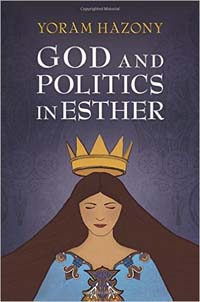God and Politics in Esther, 2nd Edition, by Yoram Hazony; Cambridge University Press; (2015); ISBN-10: 1107583454; $18.27 on Amazon. Rating ***** out of 5 Stars.
By Rabbi Michael Leo Samuel

 CHULA VISTA, California — Yoram Hazony’s exposition of the Book of Esther is priceless. In my Judaism 101 class, everyone read a little bit from God and Politics in Esther and the discussions that ensued made the time move so quickly . . . All my students quickly ordered their copies; they are all having an exciting time discussing it with their friends.
CHULA VISTA, California — Yoram Hazony’s exposition of the Book of Esther is priceless. In my Judaism 101 class, everyone read a little bit from God and Politics in Esther and the discussions that ensued made the time move so quickly . . . All my students quickly ordered their copies; they are all having an exciting time discussing it with their friends.
The Book of Esther has always been one of the most enigmatic books of the Bible. The absence of God’s Name in this charming book gives it a unique distinction among all the other biblical books. As Hazony points out in his introduction:
When the rabbis spoke of the giving of Torah to the Jewish people, they argued that it had been accepted not once, but twice: Once at Sinai at the beginning of the Bible, and then again at the end, in the time of Esther. (p.2).
The nexus of Sinai and Esther provides a remarkable contrast. The theophany (revelation) at Sinai is replete with what moderns describe as “special effects,” the background and sensory images overpowered the people. But the acceptance of the Torah in Esther’s time marks an absence of the Divine Presence. God is hidden, and Esther’s name intimates a very different kind of reality, Hazony argues, one where the voices of the prophets are no longer discernable:
Esther describes a world in which the Jews are distant from their land, their tradition, and their God . . .(p.2)
Like a master artist, Hazony describes Jewish vulnerability at this point in history, where the Jews are no longer master of their own destinies; they exist at the whim of a Persian King who with the power of a word, could decree life and death—as Queen Vashti quickly discovered. He notes:
In exile, the Jews must live in dispersion, their institutions weak, their concerns wandering far from Jewish things, and their politics alienated from every obvious source of cohesiveness, direction and strength. It is clear at the outset that under such conditions, there is no possibility of freely seeking and implementing any Jewish ideal … (p.2).
Esther reveals the fragility of the Jewish people who are a minority living in a powerful empire that can scarcely notice its Jewish subjects. The Jewish people themselves are not sure where and how they fit; their ambivalence can be seen even in how Mordechai and Esther regard their Jewish heritage by assimilating to their new home. Mordechai’s message to Esther, when she is taken to the harem, “ Just fit in!”
Most Orthodox friends I know might not agree with Hazony’s view that Mordechai and Esther were assimilated Jews (p. 1). However, a similar argument certainly could be made about Joseph, who takes on a completely new identity once he becomes the viceroy of Egypt (Gen. 41:41-45).
Reminiscent of Malbim’s commentary on the Book of Esther, Hazony points out that King Achashverosh never regarded his wife Vashti as a life partner and mate. He viewed her as yet another, “accoutrement in his demonstration of total power: The empire is to admire her object beauty and to be impressed that the king has—as the Talmudic scholar Rav depicts Achashverosh as saying—such a “vessel” for his “use” (p. 11).
Although there is an almost surreal quality to the Book of Esther, modern readers often fail to take its message seriously. The old Jewish joke about the common theme of most Jewish holidays, “They tried to kill us but failed; let’s eat!” But Hazony’s Esther reveals the serious issues pertaining to our people’s minority status in a superpower that would have been scarcely aware of our existence, had Haman not scapegoated us.
Haman is a descendant of the warlike Bedouin people of Amalek, and the hatred of the Jew for him comes quite naturally. In his treatment of Amalek, Hazony shows that this once ancient marauding people of the Sinai had one simple objective, namely, terrify the Israelites and strike fear into the hearts of their foes so they will not approach their land (Exod. 17:18)
Damaged enough in early rounds of applied terror, even the most physically powerful opponent may be made to feel that control is lost and that further engagements will bring worse—even that capitulation “and peace” are preferable to further confrontation. The most basic method of terror even today is just this: the use of applied cruelty against innocents, the more efficiently to forestall the need for military engagement. (p. 65).
Excellent points!
Hazony goes on to develop a relevant distinction between Amalek and Israel. Amalek has no “fear of God” which manifests itself in his contempt for life; in contrast, God beckons Israel to always show a “fear of God” through reverence. By treating the widow, the poor, the resident alien along with the more vulnerable members of society—with respect, justice and with dignity, we individually and collectively demonstrate a respect for God, Who is always triangulated in every human relationship we encounter. The absence of this reverence for God makes every conceivable evil deed possible (see pp. 67-68).
(Buber has already written much on this subject as well.)
At any event, Haman is out to get Mordechai because he fears that the King will wake up to Haman’s real goal and political objectives. Mordechai is constantly campaigning daily against Haman and manages to influence the King “to reevaluate the wisdom of relying upon Haman” (p. 186).
In the end, Esther and Mordechai succeed in raising serious doubts to the King about his loyal vizier’s hidden agenda.
Hazony makes his most dramatic point toward the end of the book:
Esther is written so as to ensure that the following teaching cannot be missed: God’s salvation is not a thing that exists in the world without reference to the actions of men and women. God’s salvation is emergent upon the salvation that Esther and Mordechai bring about through their own efforts in the policies of Susa. If one looks for it anywhere other than in political endeavors—for example, if one’s eye is fixed on fasting and the sackcloth—then one will still have witnessed a wonder and a miracle, for one will still see that the Jews have been spared, when the warrant for their destruction had already been sealed and delivered. But one will not have understood what this miracle was, or what is that God did for the Jews. (p. 206).
His observation is certainly true. Throughout the pages of the Bible, redemption and salvation never occurs in a vacuum. There must be human actors in every biblical story of redemption. For there to be an Exodus, there must be a Moses, an Aaron, a Miriam, a Shifra and Puah. And this pattern is visible in every story of how our people managed to survive. A thought from the Zohar captures much of Haznony’s theology succinctly and clearly, “Blessings from above descend only where there is some substance and not mere emptiness” (Zohar 1:88a). And from this perspective, Esther serves to remind us that we must do everything that is politically possible within our own means to survive and hope that God will do His part in ensuring our survival.
Had some of our European Hassidic leaders realized this important lesson about political activism during the Holocaust, many more people might have been rescued.
*
Rabbi Samuel is spiritual leader of Temple Beth Shalom in Chula Vista and an author of several works on biblical topics. He may be contacted via michael.samuel@sdjewishworld.com. Comments intended for publication in the space below must be accompanied by the letter writer’s first and last name and his/her city and state of residence.